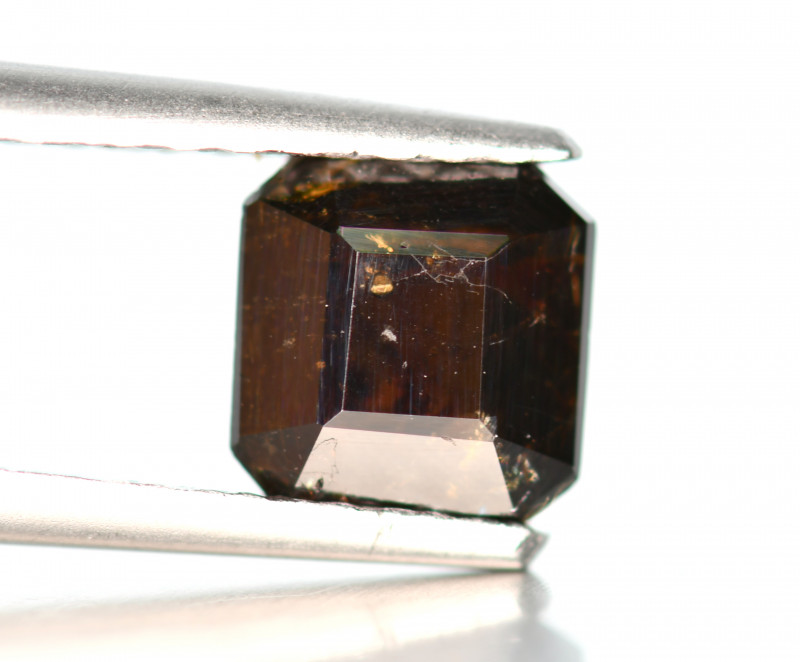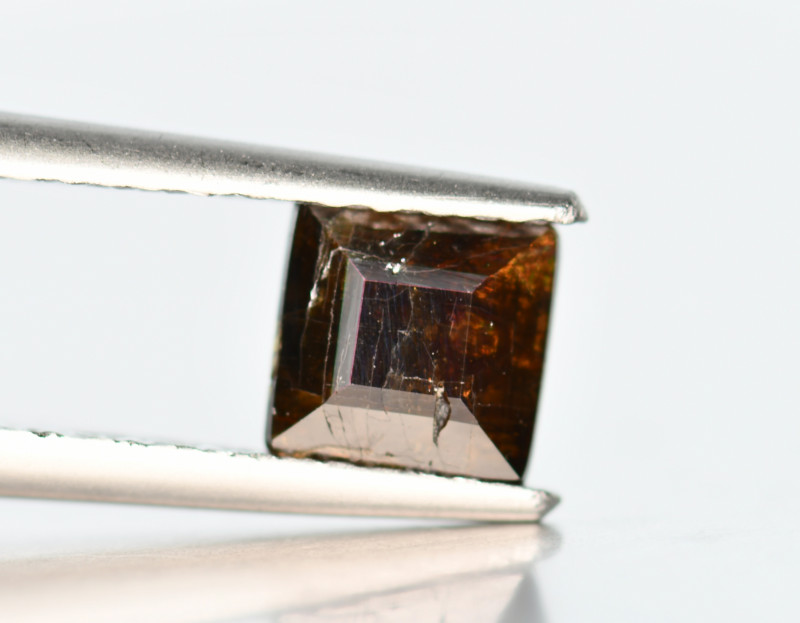
ペイン石:特性、意味、価値など
 ペイナイトはミャンマー産の赤い宝石で、元々はルビーと間違えられていました。世界で最も希少な宝石の一つとして知られており、それが私たちが「史上最高の宝石トップ10」リストに選んだ理由の一つです。
ペイナイトはミャンマー産の赤い宝石で、元々はルビーと間違えられていました。世界で最も希少な宝石の一つとして知られており、それが私たちが「史上最高の宝石トップ10」リストに選んだ理由の一つです。
しかし、ペイナイトは最も希少な宝石なのでしょうか?2004年には24個未満のペイナイトが知られていましたが、2005年には世界で最も希少な宝石としてギネス世界記録に公式認定されました。
しかし、それ以来、何千もの破片や結晶が発見されましたが、ファセット加工可能な材料は依然として極めて不足しています。
この宝石の希少性と美しさは、コレクターや希少宝石愛好家の間でも人気です。もしご自身でペイン石の購入を検討されているなら、安心してご購入いただけるよう、この石の特性、歴史、メリット、価格など、あらゆる情報をお伝えします。

ペイン石について
ペイナイトはルビーとガーネットの両方に似ているため、この珍しい結晶は7 月(ルビーの月) または1 月 (ガーネットの月) の誕生石の代わりとなります。
さらに、伝統的な結婚40周年記念(ルビー)や結婚2周年記念(ガーネット)の宝石の代わりに、特別な贈り物として贈ることもできます。ペイナイトは単体でも、魚座と水瓶座の星座石として知られています。
ペイン石は半貴石ですが、その希少性はどの貴石( ダイヤモンド、 サファイア、ルビー、 エメラルドなど)よりも高くなっています。
しかし、なぜペイナイトはこれほど希少なのでしょうか?その希少性は、その組成に由来します。ペイナイト鉱物にはホウ素とジルコニウムが含まれており、これらが同時に見つかることは非常に稀です。実際、ペイナイト以外に両方の元素を含む鉱物は存在しません。
ペイン石の仕様と特徴
鉱物パイナイトは、カルシウム・ジルコニウム・アルミニウム・ホウ素・ケイ酸塩です。この石の理想的な組成はCaZrBAl9O18で、少量のハフニウムとチタンを含みます。
石の大部分は酸化アルミニウム(約70%)と酸化ジルコニウム(約17%)です。一般的な不純物にはクロム、バナジウム、鉄などがあり、前者2つがペイン石の色に影響を与えています。
ペイナイトに最も類似した鉱物は、希少なアルミニウムホウ酸塩鉱物であるジェレムジェバイトです。他にご存知のホウ酸塩鉱物としては、 ハウライトやロンドナイトなどがあります。
通常、ペイン石は六方晶系の細長い透明な結晶として形成されますが、結晶系は斜方晶系のように見えることもあります。
ペイン石の見分け方
ペイン石は、ルビーやガーネットといったより一般的な宝石と混同されやすいです。最初の発見者や大英自然史博物館でさえ、ペイン石をルビー、ガーネット、ブラウントルマリンといった異なる宝石と間違えたことがあります。
さらに、ペイン石の密度と色はルビーやガーネット(具体的にはアルマンディンとスペサルタイト)に似ています。
しかし、ペイナイトは複屈折性(屈折率が1つではなく2つある)を持ちますが、ガーネットは複屈折性ではありません。ルビーの場合は、屈折率の測定値で区別することができます。ルビーの屈折率は1.76~1.77で、ペイナイトよりも低いです。
屈折率や複屈折値など、ペイン石のすべての鉱物特性については、以下のリストをご覧ください。
モース硬度:7.5~8
色:赤、赤褐色、オレンジがかった赤
結晶構造:六方晶系、擬斜方晶系
光沢:ガラス質
透明性:透明
屈折率:1.787-1.816
密度:4.0~4.3
分裂:未確定
骨折:貝殻状
縞模様:赤
発光:蛍光あり - LW-UVでは弱い赤色、SW-UVでは強い赤色または緑色
多色性:ルビーレッドから淡い茶橙色または淡い赤橙色まで強く現れる。黄褐色から赤または茶紫色。ほぼ無色から淡いオレンジピンク(ピンクがかった標本)まで現れる。
複屈折:0.029
鉱物学についてはこれで十分です。ペイン石の象徴と時間の旅に飛び込んでみましょう。

ペイン石の意味と歴史
ペイナイト自体にはそれほど象徴的な意味合いはありませんが、その色彩には象徴的な意味合いがあります。赤い石であるペイナイトは、力、情熱、そして目的意識を象徴しています。
中国文化において、赤は成功と幸福の象徴でもあります。地元のお店のドアや花嫁の装飾に赤い色を使っているのを見かけることがありますが、どちらも幸運を引き寄せると言われています。
風水では、赤い石は情熱を呼び起こし、繁栄を引き寄せるために置かれます。赤は男性的で外向的な陽のエネルギーと結びついています。
最初の発見
ペイン石の名は、この石の発見者にちなんで名付けられました。イギリスの鉱物学者、宝石学者、そして宝石商でもあったアーサー・チャールズ・デイビー・ペイン(またはアーサー・C・D・ペイン)は、1950年代にミャンマー(当時はビルマ)で初めて公式にペイン石を発見しました。
ペインは当初、ルビーだと思い、大英自然史博物館に寄贈しました。博物館の鉱物学者による分析の結果、全く新しい宝石であることが証明されました。
ペインは、博物館の館長を務めていた英国の鉱物学者マックス・ヘイ博士(またはMHヘイ)とゴードン・フランク・クラリングブル博士(またはGFクラリングブル)とともに、1957年に『Mineralogical Magazine』誌でペイン石に関する調査結果を発表しました。
この最初のペイナイト(多くの人から「ペイナイト#1」と呼ばれています)は1.7グラムの結晶で、現在もロンドンの博物館に所蔵されています。分析に使用された結晶の切片(「ペイナイト#1b」と呼ばれています)は現在、カリフォルニア州パサデナにあるカリフォルニア工科大学に所蔵されています。
その後の発見
鉱物学者たちはさらに分析を進め、1976年、1986年、1996年にペイン石に関するさらなる研究結果を発表しました。しかし、1957年から2001年の間に発見されたペイン石の結晶はあと2つだけです。
2番目に発見されたペイナイトは2.118グラムの結晶で、これも大英自然史博物館に収蔵されています。3番目に発見されたペイナイトは0.27グラムの結晶で、1979年にアメリカ宝石学研究所(GIA)の宝石学者が原石標本の中から発見するまで発見されませんでした。
2001年にはミャンマーで4つ目のペイナイト原石が発見されました。2002年にはミャンマーで新たなペイナイトの産地が発見されました。しかし、2004年時点で確認されているペイナイトの宝石は24個未満で、2005年にはギネス世界記録に認定されました。
2005年後半、ミャンマーの鉱山労働者たちはついに、新たに重要なペイナイトの露頭を発見しました。2005年以前にはファセットカットされたペイナイト宝石はわずか2個しか知られていませんでしたが、それ以降、数百個のペイナイト宝石がファセットカットされています。
興味深いことに、大英自然史博物館は2007年に、茶色のトルマリンと分類して展示していたミャンマー産の石が実はペイン石であることを発見しました。
希少宝石愛好家やコレクターを喜ばせるだけでなく、ペイン石にはどんな効果があるのでしょうか?もちろん、クリスタルヒーリングです!

ペイン石の治癒特性
希少なものも一般的なものも含め、すべての宝石と同様に、ペイナイトはヒーリングストーンとして機能します。他の赤い宝石と同様に、ペイナイトの効能には情熱、活力、そしてモチベーションの向上が含まれます。
茶色の色合いを持つペイナイトは、グラウンディングや安定といった茶色の宝石の効能をもたらします。さらに、ペイナイトは、もはや役に立たない習慣や思考パターンを捨て去るのに役立つと言われています。
チャクラヒーリングにおいて、ペイナイトはどのように使われますか?ペイナイトは、体にある7つのチャクラ(エネルギーセンター)すべてに作用するチャクラストーンです。つまり、特定のチャクラの詰まりを解消するためだけに使うのではなく、すべてのチャクラを開き、整えるために使うことで、体、心、そして精神全体のバランスとエネルギーの流れを高めることができます。
クリスタルヒーリングの世界から宝石学の世界に戻りましょう。個々のペイナイトの価値はどうやってわかるのでしょうか?次回、その答えをお伝えします!

ペイン石の宝石特性
希少性が価格を決める最大の要因ではありますが、ペイン石の価値を高める他の要素としては、色、カット、透明度、カラット重量などがあります。
色
ペイナイトは赤い石ですが、原石はピンクルビーが石の表面で成長しているため、ピンク色に見えることがあります。茶色やオレンジの色合いも見られ、オレンジブラウンは最も希少なペイナイトの色です。この石の色は、クロムとバナジウムの不純物によって生じます。
ペイナイトの中には、ほぼ黒に見えるほど濃い赤色のものもあります。最高級のペイナイトは、深紅色または鮮やかなガーネットレッドの色合いをしています。
カット
ファセット加工可能なペイン石は希少で、そのわずかな量でも、その大半は内包物やフラクチャーを多く含んでいます。つまり、優れた耐久性、輝き、そして色彩といった宝石としての価値を持つペイン石であるにもかかわらず、ファセット加工は非常に難しいのです。
通常、宝石職人は脆い部分を削り取ろうとするため、浅く魅力の薄いファセットカットを施してしまいます。とはいえ、こうした希少石は依然として高値で取引されています。ファセットカットされたペイナイトの中には、クッションカット、オーバルカット、レクタングルステップカット、スクエアコーナーカットなどが施されているものもあります。
明瞭さ
クラリティとは、宝石に含まれる目に見える内包物の量を表します。光を透過するほど明るい色合いを持つ透明なペイン石では、内包物が肉眼での石の外観を変えるため、高いクラリティはより重要です。
六角形の板状の金雲母結晶は、羽毛状の内包物や小さな空洞内の薄いシートとともに、ペイン石によく見られる内包物です。
内包物が多いと、ペイナイトの耐久性も低下します。最も価値の高いペイナイトは、肉眼で内包物が確認できない、つまりアイクリーンな状態です。
カラット重量とサイズ
ペイナイトの結晶は巨大に成長することがあります。2020年3月時点のギネス世界記録によると、現在知られている最大のペイナイト標本は213.52カラット(42.7グラム)です。
2006 年に報告されたもう一つの非常に大きな標本は、ルビーも付いているにもかかわらず、なんと 3,165 カラット (633 グラム) の重さがあります。
しかしながら、ほとんどのペイン石の結晶は小さく、断片化した破片です。
 画像クレジット: Rob Lavinsky、iRocks.com – CC-BY-SA-3.0
画像クレジット: Rob Lavinsky、iRocks.com – CC-BY-SA-3.0
ペイン石の形成と産地
ペイン石は、スカルン(別名タクタイト)と呼ばれる変成岩の中に生成されます。スカルンは粗粒の石で、カルシウム、鉄、マグネシウム、マンガン、アルミニウム、シリカなどの鉱物が豊富に含まれています。
鉱山労働者は通常、宝石の砂利の中にペイン石の原石を見つけます。そこでは鉱物が森林から流れ落ちて川床に沈殿します。
ペイナイトの周辺で見つかる宝石には、金雲母、 スピネル、コランダム(サファイアとルビー)などがあります。ペイナイトはルビーの近く、あるいはルビーの上に形成されることもよくあります。
パイナイトはどこで採れるのでしょうか? パイナイトはミャンマーでのみ産出されます。最初の発見はマンダレー管区モゴック渓谷のオンガインで行われました。2002年以降、ミャンマーでは以下のような産地が新たに発見されています。
モゴック郡区のチャウピャット・ザット
モゴック郡のバウロンジー(大きなボール)
モゴック郡のイェアイ
カチン州のナミヤゼイク
さて、誰もが考えている百万ドルの価値がある質問: ペイン石の価格はいくらですか?

ペインライトの価格と価値
ミャンマーで比較的新しい産地が発見される以前は、ほぼすべてのパイナイトは博物館、非営利の宝石学研究機関、大学といった民間団体によって所有されていました。しかし、新たな産地の発見によって、少量ではあるものの、高額で取引されるパイナイトがようやく一般市場に流通するようになりました。
現在、宝石用原石のペイナイトの価格は1グラムあたり25万ドルから30万ドルです。カラットで測る場合は、1カラットあたり5万ドルから6万ドルになります。しかし、入手しやすくなってきたため(多少の値上がりではありますが)、ファセットカットされたペイナイトは1カラットあたり800ドルから6,000ドル程度で見つかるかもしれません。
小さな未加工のペイン石結晶(カットされていない)は、宝石品質でない場合は通常 1 カラットあたり 0.60 ~ 15 ドル程度と、かなり安価です。
そのような投資をするなら、ペイン石の宝石をどのように手入れすればよいかを知っておく必要があります。
ペインライトのケアとメンテナンス
ペイナイトは劈開性がなく硬度が高いものの、多くの標本に内包物や割れ目が多く見られるため、破損しやすいという欠点があります。そのため、適切な宝石のお手入れが不可欠です。
石の希少性と価格を考えると、ペイナイトを認定宝石鑑定士に持ち込み、その石の脆さを鑑定してもらうのが最善策かもしれません。ペイナイトのジュエリーは珍しいですが、ペイナイトリングのような脆い石には、 保護セッティングをお勧めします。
プロのクリーニング店に持ち込みたくない場合は、自宅で安全にペイン石をクリーニングできます。ぬるま湯と中性洗剤を混ぜ合わせ、柔らかい歯ブラシをその溶液に浸します。石を優しくこすり、石鹸カスを洗い流し、柔らかいマイクロファイバーの布で乾かします。
ペイン石を恋しがっていますか?
宝石や鉱物のコレクターでなくても、ペイナイトの美しさと魅力を堪能できます。ペイナイトは「希少宝石の聖杯」とも呼ばれています。ご自身と同じくらい希少で特別な、真に唯一無二の宝石をお探しなら、ペイナイトはまさに最適な選択肢かもしれません!
Gemstone Encyclopedia検索
最新記事
レインボーラティスサンストーンは、様々な内包物によって3つのゴージャスな光学的効果を持つ長石の一種です。燃えるように鮮やかな色合いと格子模様が、コレクターにとって希少な宝石となっています。
12th Jan 2026
チューライトは、ゾイサイト鉱物ファミリーに属する、鮮やかなバラ色の色合いを示す希少なノルウェー産の宝石で、ジュエリーのセッティングやペンダントによく使用されます。
6th Jan 2026
記事のカテゴリ
How To's is where you will find helpful articles from gem Rock Auctions on how to cut gemstones, select gemstones and buy gemstones.
9記事数

